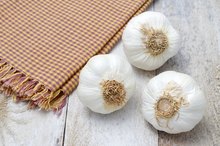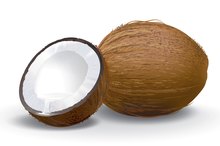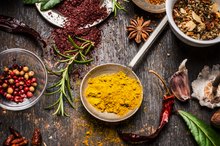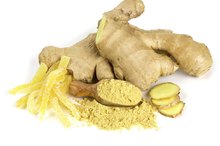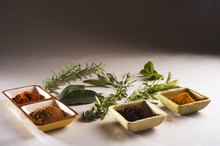Herbs That Remove Toxins or Bacterial Infections From the Body
Bacteria and other pathogens are nearly omnipresent in our world. While our immune system has the ability to protect the body from their harmful effects, it is when these invaders reach toxic levels that infection can occur. Bacterial and other infections should be treated by a trained health care professional. In addition, certain herbs may help kill bacteria and strengthen the body's natural defenses. Consult your doctor before trying herbal remedies.
If you are experiencing serious medical symptoms, seek emergency treatment immediately.
Echinacea
Echinacea, or purple coneflower, is a popular herbal remedy for the common cold and flu. It is considered antibacterial, antiviral and antimicrobial. It grows throughout North America and was used traditionally by Native Americans to treat infections and help heal wounds. Herbalists today use echinacea as a natural antibiotic. It is commonly taken in tincture or liquid extract form. Talk to your health care practitioner regarding proper use of echinacea to treat bacterial infections.
- Echinacea, or purple coneflower, is a popular herbal remedy for the common cold and flu.
- It grows throughout North America and was used traditionally by Native Americans to treat infections and help heal wounds.
Garlic
Side Effects of Too Much Echinacea
Learn More
Garlic is a prolific herb revered by chefs and herbalists alike. Its active ingredient, allicin, is antibacterial, antifungal and antiviral. It has been used for centuries to treat a variety of conditions, including influenza, the common cold and the plague. During World Wars I and II it was known as Russian penicillin. Herbalists today use it as a natural antibiotic to fight bacterial infections. According to an early study from 1985 published in the journal "Antimicrobial Agents and Chemotherapy," scientists confirmed that garlic inhibits the growth of as many as 30 different strains of bacteria.It can be eaten fresh or taken in tablet form 2. Consult your health care provider before using garlic for medicinal purposes.
- Garlic is a prolific herb revered by chefs and herbalists alike.
- Herbalists today use it as a natural antibiotic to fight bacterial infections.
Goldenseal
Goldenseal is a flowering plant that grows throughout North America. It was used traditionally in Native American and folk medicine to treat wounds, skin infections, digestive disorders and other infectious conditions. It is often combined with echinacea in herbal cold and flu remedies. In a 2010 study from "Planta Medica," researchers explained that berberine, the main chemical constituent in goldenseal, is naturally antibacterial and anti-inflammatory 3. Researchers observed antibacterial activity in extracts of goldenseal when tested against Staphylococcus aureus, the bacterium responsible for staph infections. The herb can be found in herbal teas, liquid extract or capsule form. Talk to a trained health care practitioner for proper administration of goldenseal.
- Goldenseal is a flowering plant that grows throughout North America.
- It is often combined with echinacea in herbal cold and flu remedies.
Melaleuca
Garlic for Chest Congestion
Learn More
Melaleuca, better known as tea tree, is native to Australia and New Zealand. It has potent antibacterial properties and is often used in natural cleaning products and herbal preparations. While melaleuca tea is taken internally, tea tree oil should only be used topically. It may also be found in gargles or mouthwash, but large quantities have been known to cause adverse affects. Consult your medical doctor before trying melaleuca.
- Melaleuca, better known as tea tree, is native to Australia and New Zealand.
- It may also be found in gargles or mouthwash, but large quantities have been known to cause adverse affects.
Related Articles
References
- "Phytomedicine"; Bactericidal and Anti-Inflammatory Properties of a Standardized Echinacea Extract; S. Sharma, et al.; July 2010
- "Antimicrobial Agents and Chemotherapy"; Inhibition of Mycobacteria by Garlic Extract; E. Delaha, et al.; April 1985
- "Planta Medica"; Goldenseal (Hydrastis Canadensis L.) Extracts Synergistically Enhance the Antibacterial Activity of Berberine; K. Ettefagh; December 2010
- NIH: National Center for Complementary and Integrative Health. Goldenseal. https://nccih.nih.gov/health/goldenseal
- National Center for Complementary and Integrative Health. Goldenseal. Updated November 30, 2016.
- Wallace ED, Oberlies NH, Cech NB, Kellogg JJ. Detection of adulteration in Hydrastis canadensis (goldenseal) dietary supplements via untargeted mass spectrometry-based metabolomics. Food Chem Toxicol. 2018;120:439-447. doi:10.1016/j.fct.2018.07.033
- Schwarcz J. Goldenseal. McGill University. March 20, 2017.
- Asher GN, Corbett AH, Hawke RL. Common herbal dietary supplement-drug interactions. Am Fam Physician. 2017;96(2):101-107.
- McCarty, C.A., Berg, R.L., Rottscheit, C.M. The use of dietary supplements and their association with blood pressure in a large Midwestern cohort. BMC Complement Altern Med. 2013;13:339. doi:10.1186/1472-6882-13-339
- Asher GN, Corbett AH, Hawke RL. Common Herbal Dietary Supplement-Drug Interactions. Am Fam Physician. 2017;96(2):101-107. Review.
- NIH: National Center for Complementary and Integrative Health. Goldenseal.
Writer Bio
A professional writer since 2008, Tracey Planinz writes articles on natural health, nutrition and fitness. She holds a doctorate and two professional certifications in her field, and continues to develop her education with additional classes and seminars. She has provided natural health consultations and private fitness instruction for clients in her local community.

